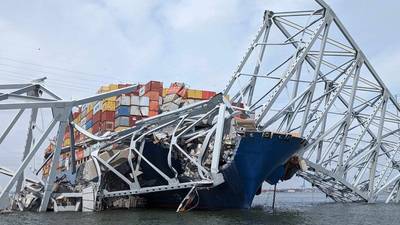Authorities Warned of Ship Approach Moments Before Baltimore Bridge Collapse
Federal investigators on Wednesday examined the cargo ship that crashed into a Baltimore bridge while emergency teams searched for bodies and details emerged of the intense efforts to save lives in the minutes before the steel span collapsed.
"Hold all traffic on the Key Bridge. There's a ship approaching that just lost their steering," someone said on police radio minutes before the 1:30 a.m. crash on Tuesday.
While voices were heard discussing next steps, including alerting any work crews to leave the bridge, one broke through to say: "The whole bridge just fell down!" The audio was carried by Broadcastify, an open-source audio streaming service.
The recording offered a glimpse of how authorities scrambled before the crash into the Francis Scott Key Bridge sent six bridge repair workers on the night shift to their deaths in the frigid black waters of Baltimore Harbor.
The Singapore-flagged Dali, a container ship the length of three football fields, had reported a loss of power before impact and dropped anchor to slow the vessel, giving authorities barely enough time to halt traffic on the bridge and likely prevent greater loss of life.
The disaster closed the Port of Baltimore, one of the busiest on the U.S. Eastern Seaboard, and created a traffic quagmire for Baltimore and the densely populated region.
The bridge collapse could cost insurers billions of dollars in claims, analysts said, with one putting the cost at as much as $4 billion, which would make the tragedy a record shipping insurance loss.
Investigators from the U.S. National Transportation Safety Board recovered the data recorder after boarding the ship late on Tuesday and returned to the vessel on Wednesday to interview the ship's crew, other survivors and emergency responders, NTSB Chair Jennifer Homendy said.
A highway team was due to examine the remains of the 1.6-mile (2.6-km)-long bridge for answers to how and why the container ship smashed into a support pillar.
Rescuers pulled two workers from the water alive on Tuesday, and one was hospitalized. The six presumed dead included immigrants from Mexico, Guatemala and El Salvador, according to the Mexican Consulate in Washington.
One from Mexico was rescued, and two were missing, said Mexico President Andrés Manuel López Obrador.
The bridge work crew was repairing potholes on the road surface when the Dali plowed into the pylon as it left Baltimore for Sri Lanka.
A trestled section of the bridge almost immediately crumpled into the water, sending vehicles and workers into the 50-foot-deep waters at the mouth of the Patapsco River.
Divers were looking for their remains in a cold steady rain.
"They are down there in darkness where they can literally see about a foot in front of them. They are trying to navigate mangled metal," Maryland Governor Wes Moore said.
Focus on opening port, cause of crash
The U.S. Coast Guard priorities are to restore the waterway for shipping, stabilize the vessel and extricate it, Vice Admiral Peter Gautier said at a White House news briefing.
"The real critical thing here is that, as you know, a portion of the bridge remains on the bow on that ship," he said. The Coast Guard would work with the U.S. Army Corps of Engineers to remove the debris before the vessel is moved, he said.
The wreck drew attention to the vessel's safety record, but Gautier said, the ship had a "fairly good safety record."
Of the ship's 4,700 cargo containers, 56 hold hazardous materials but there is no threat to the public, he said. Two containers went overboard during the crash but they did not contain hazardous materials.
The ship is carrying more than 1.5 million gallons of fuel oil, he added.
Data from the ship will provide investigators with a timeline of what happened, the NTSB's Homendy told reporters as she prepared to board the vessel. The NTSB scheduled a briefing for Wednesday evening.
The process will involve taking photos of the ship and the 47-year-old bridge and getting electronic logs. The agency will also examine whether contaminated fuel played a role in the ship's power loss, she said.
The Port of Baltimore handles more automobile freight than any other U.S. port - more than 750,000 vehicles in 2022, according to port data, as well as container and bulk cargo ranging from sugar to coal.
Still, economists and logistics experts said they doubted the port closure would unleash a major U.S. supply chain crisis or major spike in the price of goods, due to ample capacity at rival shipping hubs along the Eastern Seaboard.
The loss of the bridge also snarled roadways across Baltimore, forcing drivers onto two other congested harbor crossings and complicating daily commutes and regional traffic detours for months or even years to come.
(Reuters - Reporting by Gabriella Borter; Additional reporting by Rami Ayyub, Nandita Bose, Doina Chiacu, Ted Hesson, Katharine Jackson, Mike Segar, David Shephardson; Writing by Doina Chiacu and Steve Gorman; Editing by Howard Goller)











